|
|
|
__________________________________________________________________________________________________________________________________
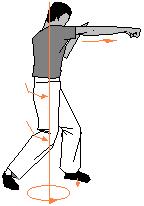 |
|
Attacking combinations.....
This page is not intended as instructional -rather discursive. It runs through several fighting combinations which may be of interest to fellow open-minded martial artists. It must also be stressed that these combinations are not specific to either competition or self-defence. Transferring them into either context obviously requires a reappraisal of their relative merits.
Combination #1 Jab, distract low, fill gap
In a dynamic situation, throw a jab. Assuming that the covering action of the defender allows, lunge in with a knee to the midsection (or groin in the street?). They are likely to drop their guard either to block the knee or as a reflex to it hitting home. If practical, latch their shoulder or neck with you semi-retracted lead hand (as this gives you both a reference point and an element of control) and smash an elbow into their face. Follow up as circumstances allow.
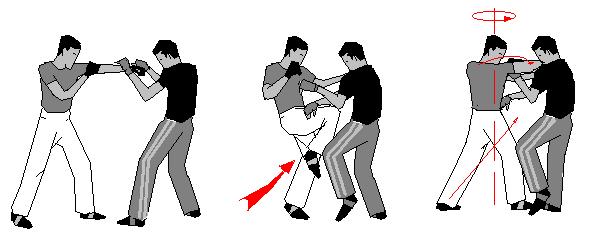
If you miss with the roundhouse elbow, one option is to bring it back in a hacking action, or if the opponent is retreating, a backfist. This would open up the hips again for a more powerful follow up with the rear (left in illustration) hand.
|
Combination #2 roundhouse kick, spinning back kick -Contributed by Pluckyew
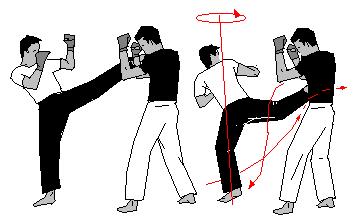 |
A simple kicking combination
for sparring. From a dynamic situation, a lead leg
roundhouse kick is thrown with a snapping action (mainly
knee-generated power). This type of kick is quite weak
and hardly a fight stopper. But it often scores in point
type fighting and competitions. Here it is merely
employed with the more powerful follow-up in mind. On
retraction, it is placed on the ground to the inside of
the opponent (a dangerously narrow and not normally
desirable positioning). However, this facilitates as
spinning attack with the rear leg such as the back kick
shown here. If it lands it can be a debilitating blow. Variations Spinning hook kicks can also be set up this way. If the opponent is far enough away or retreating, a jumping-spinning-back kick, which can be awesomely powerful, can also be used. |
Combination #3 Jab, spinning backfist
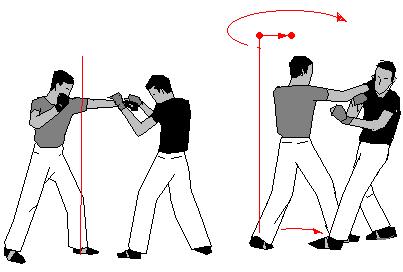 |
Of all the backfist methods,
the spinning backfist is generally the most powerful.
Like other spinning attacks, it is a good surprise attack
for sparring. In order to achieve surprise, it is often a good idea to disguise the set-up with some sort of a lead-hand or leg technique. Here a jab is thrown to gage range and set-up the spinning attack. Some people raise the knee as they spin. This can help as a defence and can also trick the opponent into expecting a spinning kick rather than strike. But it is not strictly necessary to achieve the aim. Full contact sports have shown that this move can be a convincing fight stopper. If the strike misses or falls short, it can be used to sweep away the guard free for a follow-up strike. |
Combination #4 Jab, uppercut, headlock
A rather brutal sequence which incorporates two ungentlemanly tactics; a) holding/pulling an opponent onto a strike and b) obtaining a headlock and then pummelling the opponent. But since when was there such a thing as 'cheating' in fighting?
Headlocks are perhaps under exploited in martial arts, although wrestling and grappling employ them. We will recall that at school, headlocks were common. Most martial artists will tell you how easy they are to get out of. But is it so easy when the locker is pummelling your face? And if they went for your eyes, would you have time to escape first? The danger in headlocks is too often underestimated?
The combination opens as ever with the trusty jab to gage range and disguise the follow-up. Rather than retracting the jab, the attacker uses it to latch behind the opponent's shoulder or neck. This makes it much harder for the defender to retreat out of the follow-up uppercut. The uppercut could be replaced with a straight rear-hand punch, elbow etc. In fact, this combination works well even if they are in the process of counter-punching with their own lead and the rear-hand attack has to morph into a block.
The follow-up from here is to step in closer, turning inwards as you slip your lead hand, from the latch, around the back of the head so that the inside of the elbow passes right across it. Continuing as one movement, swing your lead hand down towards his throat so as to grip his neck between your body and your forearm. Note that in doing this you are turning to face the same direction as the opponent. Squeezing his neck gives a strangling effect although it should be noted that this is much less so than many more sophisticated strangles. Neither is it the primary aim to strangle the opponent. Apply bodyweight to his neck trying to force him downward towards the front. Pushing backwards can be effective also but can equally lead to stumbling to the ground.
The headlock can be secured in three main ways:
1. By bringing your free arm under his chin and clasping the hands. This adds a choking action and makes it more realistic to choke out the defender. But against an experienced martial artist this choke isn't the most secure. And it leaves his right hand free to counterattack.
2. By grabbing his right to stop it from countering. This leaves your other hand free to pummel/gauge but requires more muscle power than the other two.
3. By grabbing your own clothing near the waist with your lead hand and using it as leverage to squeeze. This leaves your other hand free to attack his face. Although his right hand is free to counter/cover-up, we can rely on the pummelling to distract him towards the latter, which is unlikely to be effective against your continuous barrage of strikes.
In the sequence we have chosen the third method of securing the headlock. Note that the defender has blocked the uppercut, but it counts for little in the greater scheme of things:
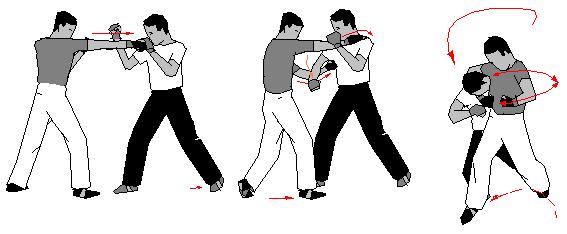
Combination #5 Jab, side-kick, reverse, roundhouse, follow-up -Contributed by Pluckyew
Although the longer the set-piece combination the less likely it is to go to plan, long combinations can bring about good follow-up training. Here the attacker starts with the ever-faithful jab distracter -in this case stepping forward to make impact solidly on the opponent's lead side. This is followed seamlessly with a slip-step lead side kick to the ribs (or midsection). The side kick in turn sets up a rear hand attack, such as the (boxing influenced) reverse punch shown here. If the opening is suitable a hook or elbow can replace the reverse punch.
The attacker then has a choice of follow-ups, depending on the opponent's cover and any 'rules'. Here a low roundhouse kick to the lead thigh is used in an attempt to collapse the opponent although a roundhouse kick to the head is a sparring option. But either way, yet further attack is in order. Pluckyew suggests that if you can grab the opponent's head, a jumping knee is an option. As is some sort of lock -the beating already metered out making the opponent more susceptible to manipulations (?).
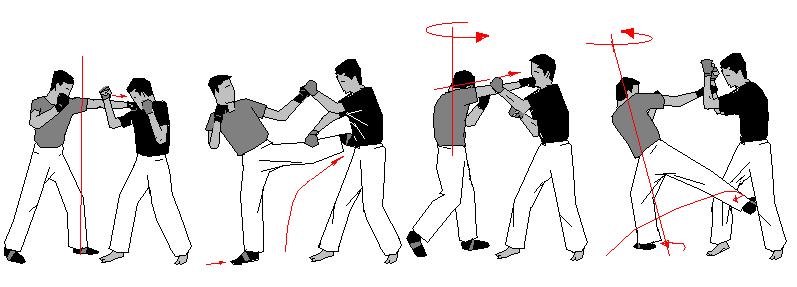
Combination #6 jab, cross, high round kick -Contributed by Keysifighter
A straightforward combination popular in full-contact martial arts such as kickboxing and muay Thai, being the stock of trade of some of the K1-series greats. Set up a powerful head kick with a jab-straight right ('cross')1-2, simply adding the kick on the end. Simple burt sweet.
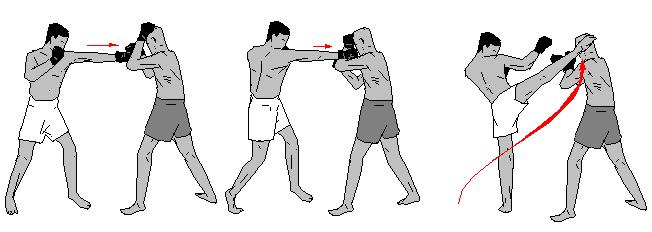
Combination #7 Lead, overhand, Tai-Otoshi
A successful Judo throw can be an awesome takedown. Here the attacker initiates with a simple lead punch, which is deflected inwards by the defender. The attacker grabs the defenders lead sleeve whilst throwing an overhand right to the defender's face. Instead of retracting the punch, the attacker takes the opportunity to grab the defender's lapel, creating a brief clinch. With a grip of the defender's sleeve and lapel, the attacker is in a position to try a throw, such as Tai-Otoshi -the drop throw. With luck and skill, the defender is thrown cleanly onto their back in a pile in front of the attacker, who, still having grip of the right sleeve, is in an ideal position to apply a lock or drop down into a knee-to-chest mount ready to pummel the defender.
